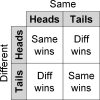Pigeons (Columba livia) approach Nash equilibrium in experimental Matching Pennies competitions
- PMID: 19794832
- PMCID: PMC2648521
- DOI: 10.1901/jeab.2009.91-169
Pigeons (Columba livia) approach Nash equilibrium in experimental Matching Pennies competitions
Abstract
The game of Matching Pennies (MP), a simplified version of the more popular Rock, Papers, Scissors, schematically represents competitions between organisms with incentives to predict each other's behavior. Optimal performance in iterated MP competitions involves the production of random choice patterns and the detection of nonrandomness in the opponent's choices. The purpose of this study was to replicate systematic deviations from optimal choice observed in humans when playing MP, and to establish whether suboptimal performance was better described by a modified linear learning model or by a more cognitively sophisticated reinforcement-tracking model. Two pairs of pigeons played iterated MP competitions; payoffs for successful choices (e.g., "Rock" vs. "Scissors") varied within experimental sessions and across experimental conditions, and were signaled by visual stimuli. Pigeons' behavior adjusted to payoff matrices; divergences from optimal play were analogous to those usually demonstrated by humans, except for the tendency of pigeons to persist on prior choices. Suboptimal play was well characterized by a linear learning model of the kind widely used to describe human performance. This linear learning model may thus serve as default account of competitive performance against which the imputation of cognitively sophisticated processes can be evaluated.
Keywords: behavioral economics; choice; competition; key peck; mixed-strategy equilibrium; model; pigeons.
Figures






Similar articles
-
Like chimpanzees (Pan troglodytes), pigeons (Columba livia domestica) match and Nash equilibrate where humans (Homo sapiens) do not.J Comp Psychol. 2019 May;133(2):197-206. doi: 10.1037/com0000144. Epub 2018 Oct 29. J Comp Psychol. 2019. PMID: 30372107 Free PMC article.
-
Human and pigeon suboptimal choice.Learn Behav. 2019 Dec;47(4):334-343. doi: 10.3758/s13420-019-00391-8. Learn Behav. 2019. PMID: 31429009
-
Sunk cost: pigeons (Columba livia), too, show bias to complete a task rather than shift to another.J Comp Psychol. 2012 Feb;126(1):1-9. doi: 10.1037/a0023826. Epub 2011 May 16. J Comp Psychol. 2012. PMID: 21574688
-
Differences in rats and pigeons suboptimal choice may depend on where those stimuli are in their behavior system.Behav Processes. 2019 Feb;159:37-41. doi: 10.1016/j.beproc.2018.11.012. Epub 2018 Dec 6. Behav Processes. 2019. PMID: 30529687 Review.
-
Suboptimal choice by pigeons: an analog of human gambling behavior.Behav Processes. 2014 Mar;103:156-64. doi: 10.1016/j.beproc.2013.11.004. Epub 2013 Nov 27. Behav Processes. 2014. PMID: 24291801 Free PMC article. Review.
Cited by
-
Pupil Correlates of Decision Variables in Mice Playing a Competitive Mixed-Strategy Game.eNeuro. 2022 Mar 11;9(2):ENEURO.0457-21.2022. doi: 10.1523/ENEURO.0457-21.2022. Print 2022 Mar-Apr. eNeuro. 2022. PMID: 35168951 Free PMC article.
-
Competitive and cooperative games for probing the neural basis of social decision-making in animals.Neurosci Biobehav Rev. 2023 Jun;149:105158. doi: 10.1016/j.neubiorev.2023.105158. Epub 2023 Apr 4. Neurosci Biobehav Rev. 2023. PMID: 37019249 Free PMC article. Review.
-
Like chimpanzees (Pan troglodytes), pigeons (Columba livia domestica) match and Nash equilibrate where humans (Homo sapiens) do not.J Comp Psychol. 2019 May;133(2):197-206. doi: 10.1037/com0000144. Epub 2018 Oct 29. J Comp Psychol. 2019. PMID: 30372107 Free PMC article.
-
Undesirable Choice Biases with Small Differences in the Spatial Structure of Chance Stimulus Sequences.PLoS One. 2015 Aug 25;10(8):e0136084. doi: 10.1371/journal.pone.0136084. eCollection 2015. PLoS One. 2015. PMID: 26305097 Free PMC article.
-
Internal-Clock Models and Misguided Views of Mechanistic Explanations: A Reply to Eckard & Lattal (2020).Perspect Behav Sci. 2020 Sep 11;43(4):779-790. doi: 10.1007/s40614-020-00268-6. eCollection 2020 Dec. Perspect Behav Sci. 2020. PMID: 33381688 Free PMC article.
References
-
- Binmore K, Swierzbinski J, Proulx C. Does minimax work? An experimental study. Economic Journal. 2001;111:445–464.
-
- Börgers T, Sarin R. Learning through reinforcement and replicator dynamics. Journal of Economic Theory. 1997;77:1–14.
Publication types
MeSH terms
Grants and funding
LinkOut - more resources
Full Text Sources

